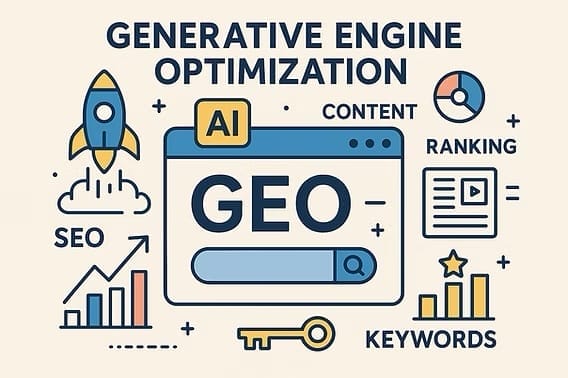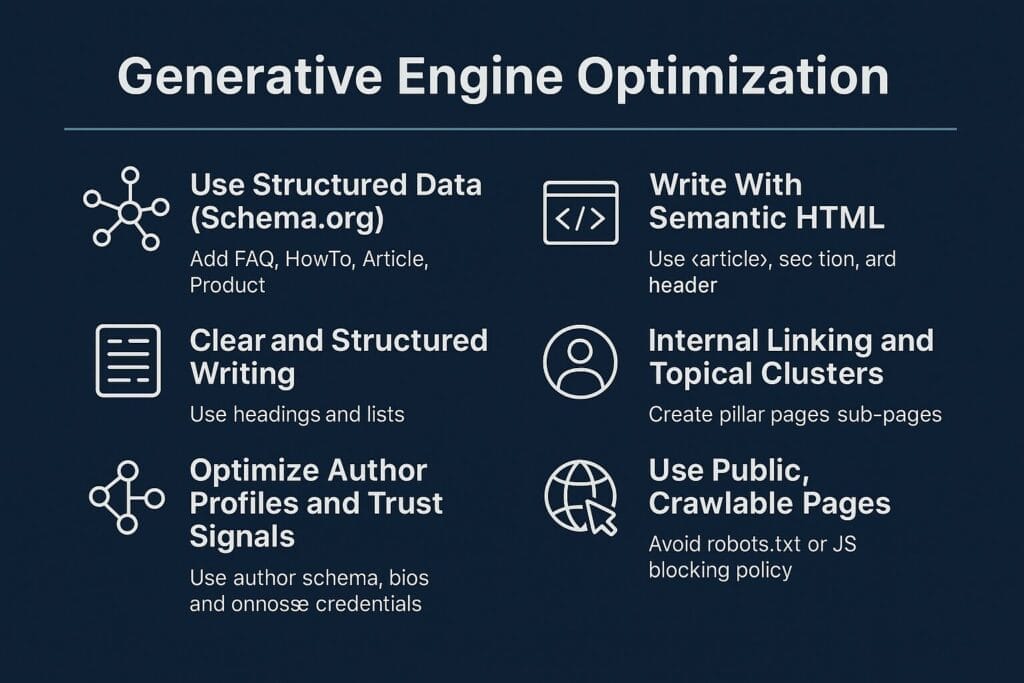Search is changing very fast. With the rise of AI tools like ChatGPT, Google SGE (Search Generative Experience), and Bing Copilot, how your content is found, interpreted, and presented is fundamentally different from traditional search. Generative Engine Optimization (GEO) is the emerging practice of tailoring your content and site structure for AI-driven search results.
In this post, we’ll break down:
- What Generative Engines are
- How they differ from traditional search engines
- The technical and content strategies behind GEO
- How to implement GEO on WordPress
- Tools and best practices for staying ahead
What Are Generative Engines?
Generative engines use AI to create answers instead of simply listing links. Instead of ten blue links on a page, generative engines analyze web content and respond with summaries, recommendations, or direct answers in natural language.
These engines draw from:
- Website content (HTML, schema, metadata)
- Structured data (FAQ, How-To, Products, etc.)
- Authoritative sources (Wikipedia, government sites, etc.)
- Real-time data (for some AI search experiences)
Examples include:
- Google SGE – embeds AI summaries and links at the top of search results
- Bing Copilot – generates full answers based on web sources
- ChatGPT with web browsing – can synthesize and link back to your content
- Perplexity AI, You.com, and others
If your site content is clear, well-structured, and useful, these engines are more likely to quote or link to it directly.
How Generative SEO Differs from Traditional SEO
| Traditional SEO | Generative SEO (GEO) |
|---|---|
| Optimizes for rankings | Optimizes for citations and summaries |
| Focuses on keywords | Focuses on concepts, clarity, and structure |
| CTR depends on snippets | Citation depends on data quality and relevance |
| Uses backlinks for authority | Uses topical depth and trust for inclusion |
| Prioritizes SERP visibility | Prioritizes AI comprehension and extraction |
Why GEO Matters (Even If You Rank #1)
In traditional SEO, the goal is to show up near the top of Google. In generative search, the goal is to be referenced or quoted directly by the AI.
Imagine this scenario:
A user asks ChatGPT: “What are the best ways to optimize WordPress speed?”
Even if your blog post ranks #2 on Google, it might not get cited unless the AI:
- Understands your content
- Can extract specific advice
- Finds clear structure (headings, lists, schema)
- Recognizes your authority on the topic

Technical Strategies for Generative Engine Optimization
1. Use Structured Data (Schema.org)
Generative engines love structured content. Schema markup helps AI extract exact answers.
Add:
- FAQ Schema: For common questions
- HowTo Schema: For tutorials or walkthroughs
- Article Schema: Include author, headline, datePublished
- Product Schema: For ecommerce sites
🛠️ Use plugins like Rank Math, SEOPress, or Schema Pro to manage this easily in WordPress.
2. Write With Semantic HTML
Don’t rely on just <div> and <span>. Use:
- <article>, <section>, <aside>
- <h1> to <h6> properly (no skipping levels)
- <ul>, <ol>, <dl> for lists and definitions
- <blockquote> for quoted text
Semantic HTML improves accessibility and makes it easier for AIs to parse your content.
3. Clear and Structured Writing
Think like an AI:
- Use concise paragraphs and descriptive subheadings
- Answer one question per section
- Use bulleted or numbered lists when explaining steps
- Add TL;DR summaries or “Key Takeaways”
The goal is to make your content easy to skim and easy to extract.
4. Internal Linking and Topical Clusters
AI tools consider content relationships. Create topic clusters:
- One pillar page (e.g., “Ultimate Guide to WordPress Security”)
- Multiple sub-pages (e.g., “Using WordFence,” “Disabling XML-RPC,” etc.)
- Internally link everything clearly
This builds topical authority and helps AI engines understand the breadth of your expertise.
5. Optimize Author Profiles and Trust Signals
AIs like citing trusted sources.
- Create detailed author bios using Person schema
- Include credentials, expertise, and social proof
- Link to LinkedIn, GitHub, or speaker pages where relevant
- Use HTTPS, fast-loading pages, and clear branding
Google’s E-E-A-T (Experience, Expertise, Authoritativeness, Trustworthiness) applies more than ever in GEO.
6. Use Public, Crawlable Pages
Generative engines don’t log in or crawl private content. Make sure:
- Content is indexable
- Not blocked by robots.txt
- Not hidden behind JavaScript-only rendering
Avoid putting your best answers only in PDFs, modals, or AJAX-loaded elements.
7. Submit to Bing & Google Search Console
Ensure your sitemap and structured data are picked up:
- Submit sitemap to Google Search Console and Bing Webmaster Tools
- Use tools like URL Inspection to see how your content is rendered
This improves visibility in both traditional and generative search indexes.
GEO for WordPress: Best Practices
If you’re on WordPress, here’s how to implement GEO strategies easily:
| Task | Recommended Plugin / Tool |
|---|---|
| Schema Markup | Rank Math, Schema Pro, SEOPress |
| Sitemap Generation | Yoast, Rank Math |
| Author Bio Schema | Simple Author Box, Ultimate Author Box Lite |
| FAQ Block | Native Block Editor + FAQ schema plugin |
| Internal Linking | Link Whisper |
| Speed Optimization | WP Rocket, FlyingPress, LiteSpeed Cache |

Blocking AI Bots: What Site Owners Should Know
As AI-driven search becomes more prevalent, site owners face a new dilemma: should you allow AI crawlers to access your content?
Blocking AI bots has become a hot topic as generative models increasingly crawl the web to gather training data or generate real-time answers. A site owner might choose to block these bots to protect their intellectual property, prevent unauthorized use of their content, or ensure they’re not contributing to commercial AI tools without consent or compensation. For publishers, educators, and creators who rely on traffic, blocking bots can also help preserve the value of their content by forcing AI platforms to negotiate access. On the other hand, blocking AI crawlers may limit your visibility in emerging AI search tools like ChatGPT, Bing Copilot, or Perplexity, which can cite and link to your content if it’s accessible.
If your goal is to build brand authority or drive traffic from AI-assisted search experiences, allowing some bots may be beneficial, especially for content designed with Generative Engine Optimization (GEO) in mind. Ultimately, the decision depends on whether your priority is protecting your content or maximizing reach in the evolving AI-driven search landscape.
Common AI Crawlers to Know About
- GPTBot – used by OpenAI (ChatGPT)
- CCBot – Common Crawl archive used by many AI models
- ClaudeBot – from Anthropic
- PerplexityBot – for Perplexity.ai
- Google-Extended – Google’s opt-out crawler for AI training
You can block them in your robots.txt:
User-agent: GPTBot
Disallow: /
User-agent: CCBot
Disallow: /
User-agent: ClaudeBot
Disallow: /But Should You Block AI Bots?
Here’s where it affects Generative Engine Optimization (GEO):
| If You Block AI Bots | If You Allow AI Bots |
|---|---|
| Your content won’t appear in some AI answers or summaries | Your content may be cited, quoted, or linked |
| You retain more control over your IP | You give up some usage rights, often without credit |
| No chance of AI-generated traffic | Possible indirect traffic or exposure |
It’s a trade-off. If visibility in AI search experiences is a priority, then blocking AI bots can hurt your GEO.
Cloudflare’s Default AI Bot Blocking (July 2025)
In a major shift, Cloudflare announced that as of July 2025, it automatically blocks known AI crawlers by default unless site owners explicitly allow them. This decision reflects Cloudflare’s growing concern over how generative AI models are harvesting web content without consent, compensation, or attribution. According to Cloudflare, many AI companies are profiting from scraping publicly available websites to train their models and generate answers, often without offering anything in return to the original content creators. These models frequently use the content without linking back to the source, depriving creators of visibility, traffic, and credit. Cloudflare argues this creates a significant power imbalance between content owners and tech giants building commercial AI products. By blocking these crawlers by default, Cloudflare is pushing back against the assumption that public content is free for unrestricted AI use. Their goal is to reassert control for website owners, advocating for a consent-based system where AI companies must request permission and potentially compensate creators. While site owners can still opt in to allow specific bots through their Cloudflare dashboard, the default posture now favors protection over unrestricted access. This policy signals a broader shift in how the web is responding to the rise of generative AI, and places greater emphasis on creator rights and long-term content sustainability.
This means:
- If your site is on Cloudflare (free or paid), AI bots are now likely being blocked
- Your content may stop appearing in tools like Perplexity, Claude, and ChatGPT Browse
- You need to opt in manually if you want AI engines to access your site
How to Check or Override This
In your Cloudflare dashboard:
- Go to Security > Bots
- Review the “AI Crawler Management” section
- You can allow or block specific crawlers
Or, use Firewall Rules to create your own logic.
Implications for GEO
This change puts the power back into your hands. If you want your content referenced in AI search, you need to:
- Unblock specific AI bots in Cloudflare
- Monitor your robots.txt file
- Decide if citation and AI exposure is worth the trade
If you prefer to protect your content, Cloudflare now enforces that by default, no extra work needed.
Advanced Considerations for Generative Engine Optimization
As generative search technology evolves, so should your optimization strategy. Beyond the core GEO principles like structured data, semantic HTML, and content clarity, there are several emerging areas that deserve attention. These considerations can help you stay ahead of the curve and make your content not just visible—but valuable—in an AI-driven web.
Attribution Challenges and Citation Accuracy
Generative engines don’t always link to or credit sources properly, making it harder for creators to receive recognition or traffic. Understanding how and when AI cites content can help shape your strategy.
Embedding Attribution Hooks
Use branded language, named quotes, and contextual signals to encourage AI models to recognize and cite your site. Phrasing content in a way that sounds quotable can increase your chances of being referenced.
Monitoring AI Mentions and Citations
Tools like Perplexity, Bing Copilot, and ChatGPT with browsing can help you check if your content is being surfaced. Tracking these mentions gives you insight into how your content is interpreted by generative engines.
GEO Metrics and KPIs
Since standard analytics may not capture AI-driven exposure, consider alternative success metrics like branded search growth, citation frequency, topical authority, and indirect traffic lift.
Ethical and Legal Considerations
There’s growing debate around copyright, scraping, and fair use in the age of AI. Site owners should be aware of potential legal shifts and assess their comfort with how their content is being used.
Future-Proof Content Architecture
Structuring content in modular, self-contained blocks (like FAQs, tips, and summaries) increases the chance of being parsed and quoted accurately by generative engines and voice assistants.
Multilingual GEO
If your site serves a global audience, optimizing for multilingual generative engines can expand your reach. Include hreflang tags, translated content, and schema to support cross-language visibility.
Tools to Monitor GEO Impact
Since GEO impact isn’t always shown in your Google rankings, use these tools:
- Google SGE Labs (if available) – See how your site is cited
- Bing Chat/Copilot – Ask questions to see if your content appears
- ChatGPT with browsing – Test your brand visibility
- Perplexity.ai – Look for site citations in AI answers
Also watch your referral sources in analytics for AI-based engines.
Future-Proofing Your SEO Strategy
GEO isn’t replacing SEO, it’s extending it. By thinking like an AI and structuring your content for clarity, depth, and authority, you’re preparing for the next evolution of search.
Generative engines reward:
- Clarity
- Structure
- Topical depth
- Trust
If your site delivers that, you’ll be more likely to land citations, mentions, and traffic from a growing share of AI-driven user journeys.
Thrive Using GEO Today
Generative Engine Optimization is still evolving, but early adopters will have a significant edge. Whether you’re a blogger, business owner, or WordPress developer, now is the time to prepare your content for the AI-driven future of search.
Focus on structure, substance, and schema, and you’ll not only survive the shift, you’ll thrive in it.



